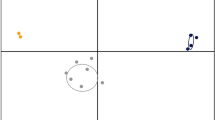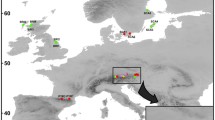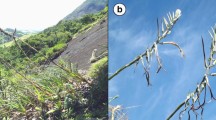Abstract
Acacia senegal (L.) Willd. is the main species producing the internationally traded gum arabic. Genetic studies of this species are rare and until now the chromosome number was thought to be diploid (2n = 2x = 26). Here, using chromosome number counting, we demonstrate for the first time that tetraploids (2n = 4x = 52) also occur in A. senegal. Nuclear and chloroplast microsatellite markers were used to estimate and compare genetic variation within this newly described polyploidy complex in the Sudano-Sahelian region in Africa. Genetic diversity was higher in diploids, suggesting that the formation of tetraploids is recent and that mutation–drift equilibrium has not yet been reached. The two cytotypes do not have the same genetic structure and are genetically differentiated. Among tetraploids, populations are greatly differentiated and do not share the same chlorotypes. Based on these results, we discuss recurrent formation of tetraploids from different diploid progenitors across the distribution range of A. senegal in the Sudano-Sahelian zone.








Similar content being viewed by others
References
Addinsoft© (1995-2007) XLSTAT Version 2007.8.04. Available at http://wwwxlstatcom
Albertin W, Alix K, Balliau T, Brabant P, Davanture M, Malosse C, Valot B, Thiellement H (2007) Differential regulation of gene products in newly synthesized Brassica napus allotetraploids is not related to protein function nor subcellular localization. BMC Genomics 8(56):15p
Anderson MJ, Willis TJ (2003) Canonical analysis of principal coordinates: a useful method of constrained ordination for ecology. Ecol 84(2):511–525
Assoumane AA, Vaillant A, Mayaki AZ, Verhaegen D (2009) Isolation and characterization of microsatellite markers for Acacia senegal (L.) Willd., a multipurpose arid and semi-arid tree. Mol Ecol Resour 9(5):1380–1383. doi:10.1111/j.1755-0998.2009.02669.x
Baack EJ, Stanton ML (2005) Ecological factors influencing tetraploid speciation in snow buttercups (Ranunculus Adoneus): niche differentiation and tetraploid establishment. Evol 59(9):1936–1944
Barnes RD, Marunda CT, Maruzane D, Zirobwa M (1999) African Acacias: genetic evaluation. Oxford Forestry Institute Department of Plant Sciences United Kingdom and Forest Research Centre Zimbabwe Forestry Commission Zimbabwe
Bentham G (1875) Revision of the suborder Mimoseae, vol 30. Transactions of the Linnean Society of London vol 30
Brown AHD, Young AG (2000) Genetic diversity in tetraploid populations of the endangered daisy Rutidosis leptorrhynchoides and implications for its conservation. Hered 85(2):122–129
Bruvo R, Michiels NK, D’Souza TG, Schulenburg H (2004) A simple method for the calculation of microsatellite genotype distances irrespective of ploidy level. Mol Ecol 13(7):2101–2106. doi:10.1111/j.1365-294X.2004.02209.x
Bryan GJ, McNicoll J, Ramsay G, Meyer RC, De Jong WS (1999) Polymorphic simple sequence repeat markers in chloroplast genomes of Solanaceous plants. Theor Appl Genet 99(5):859–867
Bukhari YM (1997) Cytoevolution of taxa in Acacia and Prosopis (Mimosaceae). Aust J Bot 45(5):879–891
Chevallier MH, Brizard JP, Diallo I, Leblanc JM (1994) La diversité génétique dans le complexe Acacia senegal. Bois For Trop 240(2):5–12
Clark LV, Jasieniuk M (2011) Polysat: an R package for polyploid microsatellite analysis. Mol Ecol Resour 11(3):562–566. doi:10.1111/j.1755-0998.2011.02985.x
Dice LR (1945) Measures of the amount of ecologic association between species. Ecol 26(3):297–302. doi:dx.doi.org/10.2307/1932409
El Amin HM (1976) Acacia laeta (R. Br.) ex. Benth., considered as a species of hybrid origin. Sudan Silva 3 (21):14-23
England PR, Usher AV, Whelan RJ, Ayre DJ (2002) Microsatellite diversity and genetic structure of fragmented populations of the rare, fire-dependent shrub Grevillea macleayana. Mol Ecol 11(6):967–977. doi:10.1046/j.1365-294X.2002.01500.x
Evanno G, Regnaut S, Goudet J (2005) Detecting the number of clusters of individuals using the software Structure: a simulation study. Mol Ecol 14(8):2611–2620
Fagg CW, Allison GE (eds) (2004) Acacia senegal and the gum arabic trade. Tropical Forestry Papers 42. Oxford Forestry Institute
FAO (ed) (1998) Gum arabic. Compendium of food additive specifications. Food and Nutrition Paper 52, addendum 6, FAO, Rome
Felsenstein J (2005) PHYLIP (Phylogeny Inference Package) version 3.6. Department of Genome Sciences, University of Washington, Seattle, distributed by the authors at (http://evolution.gs.washington.edu/phylip.html)
Gauthier P, Lumaret R, Bédécarrats A (1998) Genetic variation and gene flow in Alpine diploid and tetraploid populations of Lotus (L. alpinus (D.C.) Schleicher/L. corniculatus L.). I. Insights from morphological and allozyme markers. Hered 80(6):683–693
Gerlach WL, Bedbrook JR (1979) Cloning and characterization of ribosomal RNA genes from wheat and barley. Nucleic Acids Res 7(7):1869–1885
Goudet J (2001) FSTAT, a program to estimate and test gene diversities and fixation indices. Version 2.9.3. Department of Ecology & Evolution, Biology Building, UNIL, CH-1015 Lausanne, Switzerland, distributed by the authors at (http://www2.unil.ch/popgen/softwares/fstat.htm)
Grant V (ed) (1981) Plant speciation 2nd edn. Columbia University Press, New York
Hammer Ø, Harper DAT, Ryan PD (2001) PAST: Paleontological statistics software package for education and data analysis. Palaeontologia Electronica 4 (1):9 pp. Available at http://folk.uio.no/ohammer/past/
Hardy OJ, Vekemans X (2001) Patterns of allozyme variation in diploid and tetraploid Centaurea jacea at different spatial scales. Evol 55(5):943–954
Hardy OJ, Vekemans X (2002) SPAGeDi: a versatile computer program to analyse spatial genetic structure at the individual or population levels. Mol Ecol Notes 2(4):618–620. doi:10.1046/j.1471-8286.2002.00305.x
Hegarty MJ, Hiscock SJ (2008) Genomic clues to the evolutionary success of polyploid plants. Curr Biol 18(10):435–444. doi:10.1016/j.cub.2008.03.043
Husband BC (2000) Constraints on polyploid evolution: a test of the minority cytotype exclusion principle. Proc R Soc Biol Sci 267(1440):217–223. doi:10.1098/rspb.2000.0990
Husband BC, Schemske DW (1998) Cytotype distribution at a diploid-tetraploid contact zone in Chamerion (Epilobium) angustifolium (Onagraceae). Am J Bot 85(12):1688–1694
Husband BC, Schemske DW (2000) Ecological mechanisms of reproductive isolation between diploid and tetraploid Chamerion angustifolium. J Ecol 88(4):689–701. doi:10.1046/j.1365-2745.2000.00481.x
Jørgensen MH, Carlsen T, Skrede I, Elven R (2008) Microsatellites resolve the taxonomy of the polyploid Cardamine digitata aggregate (Brassicaceae). Taxon 57(3):882–892
Khan IR (1951) Study of somatic chromosomes in some Acacia species and hydrids. Pak J For 1(4):326–341
Kloda JM, Dean PDG, Maddren C, MacDonald DW, Mayes S (2008) Using principle component analysis to compare genetic diversity across polyploidy levels within plant complexes: an example from British Restharrows (Ononis spinosa and Ononis repens). Hered 100(3):253–260. doi:10.1038/sj.hdy.6801044
Leitch IJ, Bennett MD (1997) Polyploidy in angiosperms. Trends Plant Sci 2(12):470–476
Levin DA (ed) (2002) The role of chromosomal change in plant evolution. Oxford Series in Ecology and Evolution. Oxford University Press, New York
Luttikhuizen PC, Stift M, Kuperus P, Van Tienderen PH (2007) Genetic diversity in diploid vs. tetraploid Rorippa amphibia (Brassicaceae). Mol Ecol 16(17):3544–3553. doi:10.1111/j.1365-294X.2007.03411.x
Maslin BR, Miller JT, Seigler DS (2003) Overview of the generic status of Acacia (Leguminosae: Mimosoideae). Aust Syst Bot 16(1):1–18. doi:10.1071/SB02008
Masterson J (1994) Stomatal size in fossil plants: evidence for polyploidy in majority of angiosperms. Sci 264(5157):421–424. doi:10.1126/science.264.5157.421
Michalakis Y, Excoffier L (1996) A genetic estimation of population subdivision using distances between alleles with special references for microsatellite loci. Genet 142(3):1061–1064
Miller JT, Bayer RJ (2003) Molecular phylogenetics of Acacia subgenera Acacia and Aculeiferum (Fabaceae: Mimosoideae), based on the chloroplast matK coding sequence and flanking trnK intron spacer regions. Aust Syst Bot 16(1):27–33
Moody ME, Mueller LD, Soltis DE (1993) Genetic variation and random drift in autotetraploid populations. Genet 134(2):649–657
Motlagh S, Ravines P, Karamallah KA, Ma Q (2006) The analysis of Acacia gums using electrophoresis. Food Hydrocoll 20(6):848–854
Nei M (1978) Estimation of average heterozygosity and genetic distance from a small number of individuals. Genet 89(3):583–590
Newmaster SG, Ragupathy S (2009) Testing plant barcoding in a sister species complex of pantropical Acacia (Mimosoideae, Fabaceae). Mol Ecol Resour 9(supplement s1):172–180. doi:10.1111/j.1755-0998.2009.02642.x
Nicholson SE, Kim J, Hoopingarner J (eds) (1988) Atlas of African rainfall and its interannual variability. Florida State University, Dept. of Meteorology
Novick RR, Dick CW, Lemes MR, Navarro C, Caccone A, Bermingham E (2003) Genetic structure of Mesoamerican populations of Big-leaf mahogany (Swietenia macrophylla) inferred from microsatellite analysis. Mol Ecol 12(11):2885–2893. doi:10.1046/j.1365-294X.2003.01951.x
Obbard DJ, Harris SA, Pannell JR (2006) Simple allelic–phenotype diversity and differentiation statistics for allopolyploids. Hered 97(4):296–303. doi:10.1038/sj.hdy.6800862
Obunga EO (1995) A study of genetic systems of four African species of Acacia. DPhil, University of Sussex
Omondi SF, Kireger E, Dangasuk OG, Chikamai B, Odee DW, Cavers S, Khasa DP (2010) Genetic diversity and population structure of Acacia senegal (L) Willd. in Kenya. Trop. Plant Biol 3(1):59–70
Peakall R, Smouse PE (2006) GENALEX 6: genetic analysis in Excel. Population genetic software for teaching and research. Mol Ecol Notes 6(1):288–295
Perrier X, Jacquemoud-Collet JP (2006) DARwin software. Cirad-Bios UPR Genetic Improvement of Vegetatively Propagated Crops, distributed by the authors at (http://darwin.cirad.fr/darwin)
Petit C, Bretagnolle F, Felber F (1999) Evolutionary consequences of diploid–polyploid hybrid zones in wild species. Trends Ecol Evol 14(8):306–311
Prentis PJ, Wilson JRU, Dormontt EE, Richardson DM, Lowe AJ (2008) Adaptive evolution in invasive species. Trends Plant Sci 13(6):288–294
Pritchard JK, Stephens M, Donnelly P (2000) Inference of population structure using multilocus genotype data. Genet 155(2):945–959
Pritchard JK, Wen X, Falush D (2010) Documentation for the structure software: Version 2.3.Available at: http://pritch.bsd.uchicago.edu/structure_software/release_versions/v2.3.3/structure_doc.pdf
Ramsey J, Schemske DW (1998) Pathways, mechanisms, and rates of polyploid formation in flowering plants. Annu Rev Ecol Syst 29(1):467–501
Rausch JH, Morgan MT (2005) The effect of self-fertilization, inbreeding depression, and population size on autopolyploid establishment. Evol 59(9):1867–1875
Rieseberg LH, Willis JH (2007) Plant speciation. Sci 317(5840):910–914. doi:10.1126/science.1137729
Robertson A, Rich TCG, Allen AM, Houston L, Roberts C, Bridle JR, Harris SA, Hiscock SJ (2010) Hybridization and polyploidy as drivers of continuing evolution and speciation in Sorbus. Mol Ecol 19(8):1675–1690
Robinson J, Harris SA (2000) A plastid DNA phylogeny of the genus Acacia Miller (Acacieae, Leguminoseae). Bot J Linn Soc 132(3):195–222. doi:10.1111/j.1095-8339.2000.tb01527.x
Ross JH (1975) The Acacia complex. Bothalia 11(4):453–462
Ross JH (ed) (1979) A conspectus of the African Acacia species. Memoirs of the Botanical Survey of South Africa volume 44 Botanical Research Institute, Dept. of Agricultural Technical Services
Saitou N, Nei M (1987) The neighbor-joining method: a new method for reconstructing phylogenetic trees. Mol Biol Evol 4:406–425
Salvo-Garrido H, Travella S, Schwarzacher T, Harwood WA, Snape JW (2001) An efficient method for the physical mapping of transgenes in barley using in situ hybridization. Genome 44(1):104–110
Sampson JF, Byrne M (2012) Genetic diversity and multiple origins of polyploid Atriplex nummularia Lindl. (Chenopodiaceae). Biol J Linn Soc 105(1):218–230
Slatkin M (1995) A measure of population subdivision based on microsatellite allele frequencies. Genet 139(1):457–462
Soltis DE, Soltis PS (1989) Genetic consequences of autopolyploidy in Tolmiea (Saxifragaceae). Evol 43(3):586–594
Soltis DE, Soltis PS, Rieseberg LH (1993) Molecular data and the dynamic nature of polyploidy. Crit Rev Plant Sci 12(3):243–273
Soltis DE, Soltis PS, Tate JA (2004) Advances in the study of polyploidy since Plant speciation. N Phytol 161(1):173–191. doi:10.1046/j.1469-8137.2003.00948.x
Soltis PS, Soltis DE (2000) The role of genetic and genomic attributes in the success of polyploids. Proc Natl Acad Sci USA 97(13):7051–7057
Vassal J (1972) Apport des recherches ontogéniques et sémiologiques à l'étude morrphologique, taxonomique et phylogénique du genre Acacia. Bull Soc Hist Nat Toulouse 108:125–247
Wagner WH Jr (1970) Biosystematics and evolutionary noise. Taxon 19(2):146–151
Weising K, Gardner RC (1999) A set of conserved PCR primers for the analysis of simple sequence repeat polymorphisms in chloroplast genomes of dicotyledonous angiosperms. Genome 42(1):9–19
Wright S (1951) The genetical structure of populations. Ann Eugenics 15:323–354
Acknowledgments
We are grateful to the Faculty of Sciences of Abdou Moumouni University (Niger) for help in collecting A. senegal samples in its natural range in Niger. We are also grateful to CIRAD-Bios (Centre de Coopération Internationale en Recherche Agronomique pour le Développement, Department Systèmes Biologiques, France), Research Unit 39, where molecular analyses were carried out. This work was supported by Acaciagum project (FP6-INCO-32233) and by IRD (Institut de Recherche pour le Développement, France).
Author information
Authors and Affiliations
Corresponding author
Additional information
Communicated by M. Byrne
Rights and permissions
About this article
Cite this article
Assoumane, A., Zoubeirou, A.M., Rodier-Goud, M. et al. Highlighting the occurrence of tetraploidy in Acacia senegal (L.) Willd. and genetic variation patterns in its natural range revealed by DNA microsatellite markers. Tree Genetics & Genomes 9, 93–106 (2013). https://doi.org/10.1007/s11295-012-0537-0
Received:
Revised:
Accepted:
Published:
Issue Date:
DOI: https://doi.org/10.1007/s11295-012-0537-0




